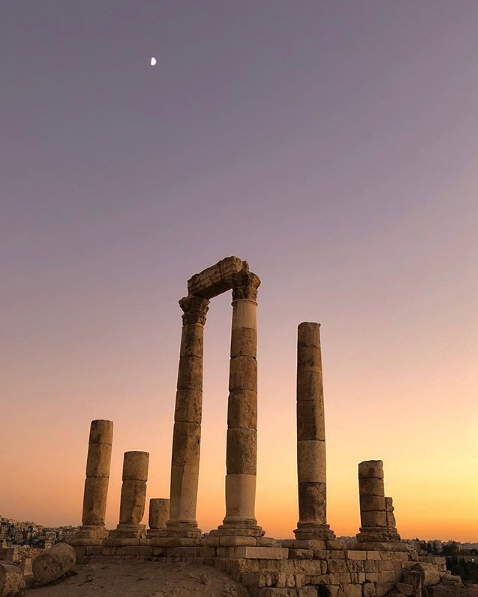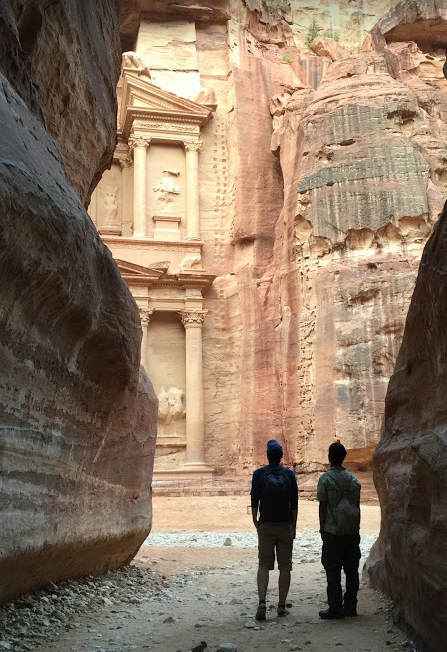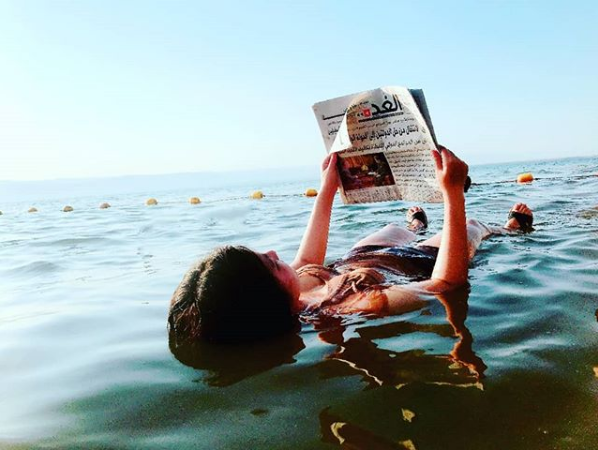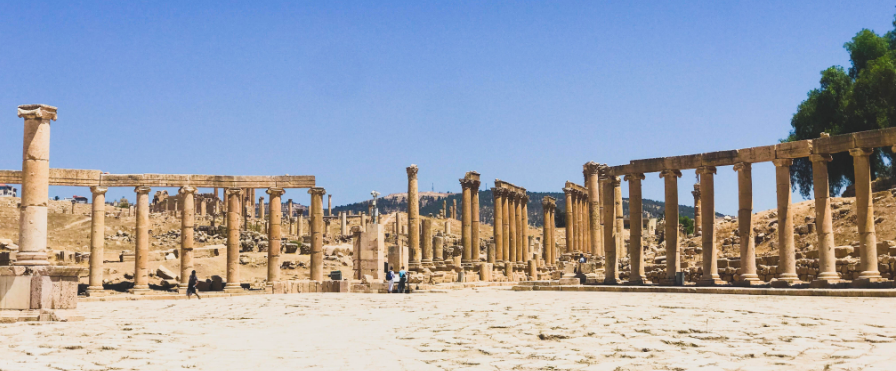Temple of Hercules, Amman Citadel. Photo taken by Adnan Ahmed, @adnanahmed9 on Instagram.
At Wadi Rum Nature Tours, we’ve decided to start writing blog posts which help our guests plan their visit to Jordan. This is our first ever post! If you have any questions about the information that you see in our articles, or you have an idea for an article, please send us a message. We hope you find this article helpful when you are planning your trip to our country.
For our first article, we’ve decided to write about our top five destinations to visit in Jordan. Of course, there are many great things to do in Jordan that didn’t make the list, but we believe that this list is a great starting point for people who are trying to plan their trip. We have included lots of links in this article so that you can read more about whatever piques your interest. We hope you enjoy :).
The Wadi Rum Desert
Unsurprisingly, Wadi Rum is our number one place to visit in Jordan. When you visit Wadi Rum, you get a perfect combination of natural beauty and Bedouin hospitality. It is the best place to experience breathtaking desert landscapes and also learn a bit about the Jordanian and Bedouin culture. Wadi Rum is the best place to try unique Bedouin cuisine and to meet people who still live a nomadic lifestyle. If you come to Jordan, there is no doubt that Wadi Rum has to be part of your itinerary!
Wadi Rum is also known as the Valley of the Moon and it is the largest wadi (valley) in all of Jordan. Today, the Wadi Rum Protected Area covers an area of 720 km2 and is a UNESCO World Heritage Site. Wadi Rum is known for its towering sandstone cliffs, imposing sand dunes, wide valleys, ancient petroglyphs and inscriptions, and of course, the friendly local people!
The most popular way to explore Wadi Rum is by Jeep however, this is not the only way to explore our desert. You can also visit the sites on the back of a camel or you can hike, scramble, or go rock climbing on the many mountains found in Wadi Rum. If you have the time to stay overnight in the desert, you can sleep in a Bedouin camp (you can see some photos of our camp here) or you can sleep in the open air under the starry desert sky. The lack of light pollution in Wadi Rum makes it a perfect destination for astrophotography.
Several popular Hollywood films have been filmed in Wadi Rum including Lawrence of Arabia with Peter O’Toole, The Martian with Matt Damon, and Rogue One: A Star Wars Story. Wadi Rum is a popular filming destination for movies which take place in outer space due to the similarities between the landscapes in Wadi Rum and on Mars.
“I was in awe of that place. It was really, really special. One of the most spectacular and beautiful places I have ever seen, and like nothing I’ve ever seen anywhere else on Earth.”
Wadi Rum is easily reached from Aqaba, Petra (Wadi Musa), and from the Wadi Araba Border Crossing with Israel. From Aqaba, there is a daily local bus which makes one trip to Wadi Rum each day. From Wadi Musa, there is a tourist bus which departs each morning and arrives in Wadi Rum around 8:30 AM. We can arrange a taxi to Wadi Rum for you from anywhere in Jordan. Let us know your transportation needs when you make a booking, and we will tell you everything that you need to know.
Petra
Petra is an absolute must-see for anyone visiting Jordan. According to the Jordan’s Ministry of Tourism & Antiquities, over 620,000 tourists visited the ancient city in 2017 making it by far the most popular tourist destination in Jordan. In addition to being a UNESCO World Heritage Site, Petra was named as one of the New7 Wonders of the World in 2001 along with other famous places like Chichen Itza in Mexico and the Taj Mahal in India.
Petra was an ancient city built by a group of people called the Nabataeans. The Nabataeans were an Arab people and Petra was an important location for the caravan trade. It is believed that Petra was built in the 4th century BC however by the beginning of the Islamic Era, the city was more or less abandoned with only a handful of Bedouins living inside. Petra was unknown to the Western world until 1812 when it was rediscovered by a Swiss explorer pretending to be an Arab.
Even today there are new secrets being uncovered at Petra. In 2016, archaeologists used satellite technology to discover a monumental structure that is estimated to be around 2150 years old. Petra has also featured in a variety of popular Hollywood films. You may recognize The Treasury as the entrance to the temple holding the Holy Grail in Indiana Jones and the Last Crusade.
The Petra Visitor Center is located on the edge of a town called Wadi Musa, which is where most tourists stay when they are visiting Petra. There is a tourist bus that leaves Wadi Musa each morning before 7:00 AM and comes to Wadi Rum. After arriving Wadi Rum, the bus returns to Wadi Musa around 9:00 AM. If you do not have your own vehicle and you want to travel between Wadi Musa and Wadi Rum in the afternoon, please let us know and we can arrange a taxi for you.
Author’s tip: The Treasury at Petra can become quite crowded during the day when the tour buses arrive from Amman and Israel. If you wake up early, you can enter the site at 6:00 AM and you will feel like you have the entire city to yourself.
The Royal Tombs at Petra. Photo taken by Mithun Bhandary, @drmik666 on Instagram.
The Dead Sea
Floating on the Dead Sea. Photo taken by Joe Parker, @joe.xplores on Instagram.
The Dead Sea is a unique destination located on the border between Jordan and Israel. The shores of the Dead Sea are located more than 430m below sea level, making it the Earth’s lowest point on land. The Dead Sea gets its name due to its high salt content. The amount of salt in the water prevents any fish or plants from living in the water.
Swimming in the Dead Sea is an interesting experience as due to the high salt content, you will float very easily. The water also feels greasy on your skin which can be a bit strange when you are experiencing it for the first time. The mud along the shoreline is thought to have many health benefits and people often cover their skin in this mud before or after they go for a swim.
If you are visiting the Dead Sea, there are a number of interesting sites nearby that you can also easily visit. Mount Nebo is a site that is mentioned in the Bible as the place where Moses had a view over the Promised Land. It is a 15 minute drive from the Dead Sea and you can have a great view over the Holy Land and the Jordan River Valley. Bethany Beyond the Jordan is a place that archaeologists believe is the baptism site of Jesus Christ by John the Baptist. The site is about a 10 minute drive from the Dead Sea and there are guided tours available. Other nearby sites that you might like to visit include the Dead Sea Museum, the Mujib Nature Reserve, and Lot’s Cave.
There are nine international hotels on the coast of the Dead Sea on the Jordanian side if you are planning to spend the night. It will take you more than four hours to drive to the resort area of the Dead Sea from Wadi. The Dead Sea is much more accessible from Amman. The drive from Amman to the Dead Sea is about one hour.
Author’s tip: The Dead Sea can be a bit dangerous if you are not careful. The shoreline can be a bit jagged so you must wear proper footwear. Also, the water is so salty that you must try to not get any in your eyes. If you do, it is better to let your tears do the work than to rub your eyes with your hands.
Relaxing in the Dead Sea. Photo taken by @eldora0x0 on Instagram.
Jerash
Hadrian’s Gate in Jerash. Photo taken by @asifaa on Instagram.
Jerash is an archaeological site located to the north of Amman and today it is considered one of the most well-preserved sites of ancient Roman architecture outside of Italy. Today, Jerash is the second most visited tourist destination in Jordan, with over 250,000 visitors in 2017.
When you walk around the ancient city, you can see a variety of ruins that were very important to the city many centuries ago. Some interesting sites include the Hippodrome, once the smallest hippodrome in the Roman Empire, the Temple of Artemis with it’s impressive pillars still intact, and the Oval Plaza, an asymmetrical plaza surrounded by 160 Ionic columns. When you enter the site, you will enter through Hadrian’s Arch. This arch was built in 129 AD in preparation for an imperial visit and now acts as the southern gate to this fantastic historical site.
You can easily reach Jerash by car from Amman. The journey takes between 60 and 90 minutes. A very cost effective way to visit Jerash is to take a bus from the Tarbabour Bus Station in Amman. A one-way ticket should only cost around 1 JOD. If you are planning a day trip from Amman, Jerash is not too far from other historical sites like Ajlun Castle, Pella, and Umm Qais.
Author’s Tip: The entrance fee to Jerash is 10 JOD but you can enter for free with the Jordan Pass. The Jordan Pass will save you money even if you are only planning to visit Petra and you require a visa-on-arrival to enter Jordan.
Jerash. Photo taken by @asifaa on Instagram.
Amman
The Temple of Hercules at the Amman Citadel. Photo taken by Joe Parker, @joe.xplores on Instagram.
Despite being the capital of the country, Amman is often overlooked as a tourist destination. Amman is by far the largest city in the country and it contains more than 40% of the country’s entire population.
Two important historical sites in Amman are the Roman Amphitheatre and the Amman Citadel. The Roman amphitheatre seats 6,000 people and it is a symbol of the city. It was built in the 2nd Century AD when the city was known as Philadelphia. The Amman Citadel has a number of interesting ruins including the Temple of Hercules and the Umayyad Palace.
In Amman, you can also visit The Jordan Museum. This museum was built in 2014 and it is the largest museum in Jordan. The museum has some very important historical artifacts such as some Dead Sea Scrolls, a copy of Mesha Stele, and the statues of 'Ain Ghazal, thought to be some of the oldest statues ever discovered, dating back to around 7000 BC.
Amman is a great starting point for day trips to some of Jordan’s lesser known tourist sites like Qasr Amra (a UNESCO World Heritage Site), Azraq (a historic wetland), and the Desert Castles of Jordan, a series of castles located in the remote eastern part of the country.
Author’s Tip: Visit the Amman Citadel at sunset. Not only will you have fantastic views over the city in all directions, but you will also get to hear a call to prayer echoing from each mosque located in downtown Amman. This is an auditory experience that should not be missed!
The Roman Theater in Amman. Photo taken by @fedeworld on Instagram.
Wadi Rum Nature Tours offers tours and accommodation in the Wadi Rum Desert, a UNESCO World Heritage Site in the south of Jordan. If you are planning a trip to Jordan, click here to read about our tours and our accommodation in beautiful Wadi Rum.












